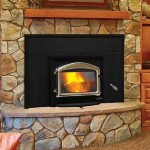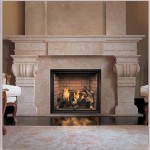White Fireplace Surround With Wood Mantel: A Timeless Combination
The combination of a white fireplace surround with a wood mantel represents a classic design choice that transcends fleeting trends. This pairing offers a blend of clean, contemporary aesthetics with the warmth and natural appeal of wood, creating a focal point in any room that is both sophisticated and inviting. The versatility of this design makes it suitable for various architectural styles, from traditional to modern, and allows for easy integration with diverse interior décor schemes.
The white surround provides a bright, neutral backdrop that enhances the beauty of the wood mantel. This contrast creates visual interest and highlights the texture and grain of the wood. The choice of wood species, finish, and mantel design allows for personalization and adaptation to individual tastes and preferences. Furthermore, the white surround ensures the fireplace remains a prominent feature without overwhelming the space, offering a sense of balance and harmony.
Selecting the right materials and design elements is crucial to achieving a cohesive and aesthetically pleasing outcome. The type of wood, the shade of white, and the overall style of the surround and mantel should complement the existing architecture and furnishings of the room. Careful consideration of scale, proportion, and detail will ensure the fireplace becomes a cherished centerpiece that enhances the overall ambiance of the home.
Key Considerations When Choosing a White Fireplace Surround With Wood Mantel
Several factors should be considered when selecting a white fireplace surround with a wood mantel. These factors influence not only the aesthetic appeal but also the functionality and longevity of the fireplace. Thorough planning and attention to detail are essential for achieving a successful and satisfying result.
The first key consideration is the style and architectural context of the room. A rustic wood mantel might beautifully complement a farmhouse-style living room but appear out of place in a minimalist, modern setting. Similarly, a sleek, contemporary white surround might clash with the ornate details of a Victorian home. Therefore, it is crucial to choose a design that aligns with the existing architectural style and enhances the overall aesthetic of the space.
The size and scale of the fireplace in relation to the room is another important aspect to consider. A large, imposing fireplace can overpower a small room, while a small, understated fireplace might get lost in a large, open space. The dimensions of the surround and mantel should be proportional to the size of the fireplace and the room it occupies, ensuring a balanced and harmonious composition.
Material selection plays a significant role in both the aesthetic and functional aspects of the fireplace. The type of wood used for the mantel will affect its appearance, durability, and maintenance requirements. Similarly, the material used for the white surround, such as marble, tile, or painted wood, will influence its texture, color, and resistance to heat and wear. Choosing high-quality materials that are appropriate for the intended use is essential to ensure the longevity and enduring beauty of the fireplace.
Exploring Different Wood Types and Finishes
The choice of wood for the mantel greatly impacts the overall look and feel of the fireplace. Each wood species possesses unique characteristics in terms of color, grain pattern, texture, and hardness. The finish applied to the wood further enhances its natural beauty and provides protection against moisture, scratches, and wear.
Oak is a popular choice for wood mantels due to its durability, strength, and distinctive grain pattern. It can be stained in a variety of colors, from light and airy to dark and rich, allowing for versatile design options. Oak is well-suited for both traditional and contemporary styles, making it a versatile choice for a wide range of interiors.
Maple is another excellent option, known for its smooth, even grain and light color. It is a dense and durable hardwood that accepts paint and stain beautifully. Maple is often used in modern and contemporary designs, where its clean lines and understated elegance are highly valued. Its lighter tone pairs exceptionally well with a bright white surround, creating a clean and airy feel.
Cherry is a prized hardwood with a rich, reddish-brown color and a smooth, satiny texture. It develops a beautiful patina over time, adding to its character and charm. Cherry is often used in traditional and formal settings, where its warmth and elegance are highly appreciated. The richness of cherry wood provides a striking contrast against a crisp white surround, creating a focal point of sophistication.
Walnut is a luxurious hardwood with a deep, chocolate-brown color and a distinctive grain pattern. It is a strong and durable wood that is resistant to decay and insect damage. Walnut is often used in high-end designs, where its richness and elegance are highly valued. The dark, dramatic tones of walnut create a bold contrast against a white surround, resulting in a statement piece that exudes luxury.
Pine is a softwood that is readily available and relatively inexpensive. It has a knotty grain and a warm, yellowish-brown color. Pine is often used in rustic and farmhouse-style designs, where its natural character and imperfections are embraced. While not as durable as hardwoods, pine can be stained or painted to achieve a variety of looks.
The finish applied to the wood mantel can significantly impact its appearance and durability. A clear finish allows the natural beauty of the wood to shine through, while a stain can enhance its color and highlight its grain. A painted finish can transform the wood into a completely different color, allowing for seamless integration with the surrounding décor.
Polyurethane is a popular finish that provides excellent protection against moisture, scratches, and wear. It is available in a variety of sheens, from matte to gloss, allowing for customization of the final look. Oil-based polyurethane offers superior durability but can yellow over time, while water-based polyurethane is more environmentally friendly and dries quickly.
Varnish is another durable finish that provides good protection against moisture and wear. It is available in a variety of sheens and can be applied in multiple coats for enhanced durability. Varnish is often used on antique furniture and traditional designs.
Lacquer is a fast-drying finish that provides a smooth, glossy surface. It is often used on high-end furniture and cabinetry. Lacquer is not as durable as polyurethane or varnish and is more susceptible to scratches and chips.
Designing the White Surround: Materials and Styles
The white surround serves as the backdrop for the wood mantel, providing a clean and neutral canvas that enhances its beauty. The choice of material and design for the surround greatly influences the overall aesthetic of the fireplace.
Marble is a luxurious and elegant material that is often used for fireplace surrounds. It is a natural stone with a unique veining pattern that adds visual interest and sophistication. Marble is heat-resistant and durable, making it an excellent choice for a fireplace surround. However, it is also relatively expensive and can be susceptible to staining.
Tile is a versatile and affordable material that is available in a wide range of colors, patterns, and textures. It is heat-resistant and easy to clean, making it a practical choice for a fireplace surround. Tile can be used to create a variety of looks, from traditional to modern, depending on the style and pattern chosen.
Painted wood is a popular and cost-effective material for fireplace surrounds. It can be easily customized to match the surrounding décor and is relatively easy to install. Painted wood is not as durable as marble or tile and may require periodic repainting.
The style of the white surround should complement the architectural style of the room and the design of the wood mantel. A simple, clean-lined surround is well-suited for modern and contemporary designs, while an ornate, detailed surround is more appropriate for traditional settings.
A flat, unadorned surround creates a minimalist look that emphasizes the beauty of the wood mantel. This style is well-suited for modern and contemporary designs, where clean lines and simplicity are highly valued.
A surround with raised panels adds depth and dimension to the fireplace. This style is often used in traditional and transitional designs, where a sense of formality and elegance is desired.
A surround with decorative moldings and carvings adds a touch of elegance and sophistication to the fireplace. This style is often used in traditional and formal settings, where ornate details are highly appreciated.

White Fireplace With Contrasting Wood Mantel Farmhouse Style Living Room Modern Decor Farm House
:max_bytes(150000):strip_icc()/sandandsisal-bdc76ad938a44d28ae9e23ef6c9fa331.jpg?strip=all)
17 Diy Fireplace Mantel Plans

53 Best Fireplace Mantel Designs To Ignite Your Creativity Living Room Decor White Mantels

Fireplace Redo After With White Wood Trim Rustic Mantelshelf And Black Painted Firebox Home Remodel

Mantels Direct 51 In W X 30 H 9 D Traditional Poplar Hollow Fireplace Mantel The Department At Com

Ideas For Fall Wood Mantle Fireplace Reclaimed Farmhouse Decor

Diy Wood Mantel Simple To Make Artsy Rule

White Fireplace Mantels

Modern Ember Lakeport 56 Wood Fireplace Mantel Surround Kit White Com

Pearl Mantels 510 48 Newport Inch Fireplace Mantel Surround With Medium Density Fiberboard White Newegg Com
Related Posts








